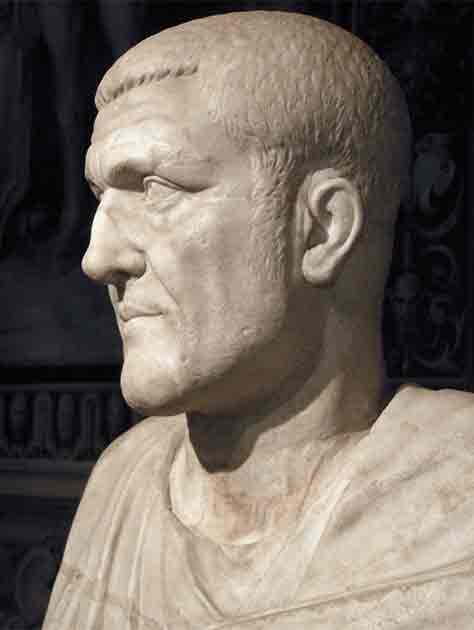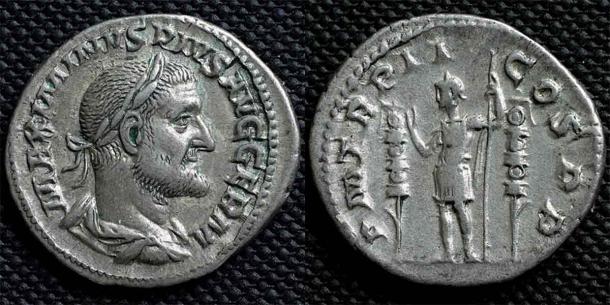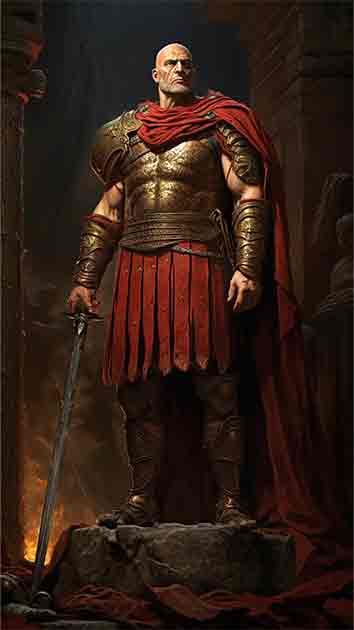
Maximinus Thrax's Turbulent Rule: Rome's Unsuccessful Giant Soldier-Emperor
The history of the vast and powerful Roman Empire was defined by its many rulers. After all, talented emperors were responsible for maintaining that venerable and very complex social machine. However, not all emperors were skilled, and some were terribly flawed. What is more, many of Rome’s Emperors hailed from the ranks of the army and their brief reigns often placed the realm into great crisis. One such army-emperor was Maximinus Thrax, whose brief reign ushered the empire into the infamous Crisis of the Third Century, an era which saw many emperors rise to the throne, only to fall swiftly thereafter. This is his story.
Maximinus Thrax: From Soldier to Sovereign
Maximinus Thrax, also known as Gaius Julius Verus Maximinus Augustus or Maximinus I, was a significant figure in the history of the Roman Empire, albeit one often overshadowed by the more famous emperors who came before and after him. His reign, though brief by imperial standards, was marked by both remarkable achievements and significant challenges, earning him a place in the annals of Roman history as the first emperor of non-senatorial origin.
- The 8 Worst Roman Emperors and Their Dastardly Deeds
- The Year of the Four Emperors, Ancient Rome's Epic Saga
He was born around 173 AD in Thrace (modern-day Bulgaria), and rose from humble beginnings to become one of the most powerful men in the Roman world. Little is known about his early life, but it is believed that he hailed from a family of barbarian origin, possibly of Gothic or Alanic descent. His towering stature—reportedly over eight feet tall—as well as his provenance, earned him the nickname Thrax, meaning “the Thracian,” a moniker that would later be appended to his imperial title.
Maximinus Thrax began his career in the military, where his physical prowess and leadership skills quickly caught the attention of his superiors. Serving under the Emperor Septimius Severus and his successors, Maximinus distinguished himself as a formidable commander, leading Roman legions in campaigns across the empire's frontiers and rising through the ranks. His military successes in quelling unrest in Germania and securing the Danube frontier earned him the favor of the army, whose loyalty would prove crucial in his eventual ascent to power.
In 235 AD, however, following the assassination of Emperor Alexander Severus, the Roman Empire plunged into a period of crisis known as the Crisis of the Third Century. In the ensuing power vacuum, the Praetorian Guard—the elite military force tasked with protecting the emperor—proclaimed Maximinus Thrax the new emperor, citing his martial prowess and popular appeal among the soldiers.
Thus began Maximinus Thrax's brief but tumultuous reign as the 27th Emperor of Rome. It is also because of this that he is considered a “barracks emperor,” being connected solely to the military and rising to the imperial throne through the ranks of the army.

Bust of Maximinus Thrax, or Maximinus I, on display at the Capitoline Museums of Rome. (MM / CC BY-SA 4.0)
A New Emperor in a Turbulent Era
Maximinus' accession to the imperial throne marked a departure from tradition in more ways than one. Not only was he the first emperor of non-senatorial origin, but his rise to power also signaled a shift in the balance of power within the Roman state. Unlike previous emperors who had been drawn from the ranks of the senatorial aristocracy, Maximinus Thrax was a man of the army, owing his allegiance primarily to the soldiers who had propelled him to the throne. He was neither an emperor of the equestrian rank, hailing from simple and poor origins, another first in the history of the empire.
And even so, Thrax accepted his role as emperor with surprising determination and confidence. As emperor, Maximinus Thrax sought to consolidate his authority and strengthen the position of the military within the Roman state. He lavished favors upon the army, increasing their pay and benefits, and expanding their privileges at the expense of the civilian population.
This militarization of the state brought Maximinus Thrax into conflict with the senatorial class, who viewed his autocratic rule and disregard for traditional institutions with suspicion and disdain. What is more, the raise of soldiers’ pay meant that the taxes throughout the empire had to be increased. Tax collectors thus employed various harsh ways to collect more money, which further alienated the emperor from the people.
Maximinus' reign was also marked by military conflict on multiple fronts. Faced with external threats from the Sassanid Persians in the east and the Germanic tribes along the Rhine and Danube frontiers, Maximinus immediately embarked on ambitious military campaigns to secure the empire's borders and expand its territory. While initially successful in repelling incursions and securing key strategic victories, Maximinus' aggressive expansionism soon began to strain the resources of the empire and alienate his subjects.
One of his first campaigns sent his armies deep into barbarian Germania. He marched on the Alemanni, long the empire’s enemies, and fought them in a vicious battle within the swamps of Agri Decumates. This victory earned him the title Germanicus Maximus.
It is likely that he capitalized on this victory by marching even deeper into Germania, ultimately facing tribes beyond the Weser River, in the Battle of Harzhorn Hill. After yet another victory, and the Germania borders secured, he retreated back to Sirmium in Pannonia, to camp for the winter. During the winter, he fought the Dacians and Sarmatians from the base at Sirmium.
Maximinus Thrax was a Soldier First and an Administrator Second
Internally, Maximinus' autocratic rule and heavy-handed policies fueled resentment and dissent among the civilian population. His attempts to centralize power and weaken the influence of the Senate met with stiff opposition from the senatorial elite, who saw their traditional privileges and prerogatives threatened by the rise of a military dictator. Meanwhile, the burden of financing Maximinus' military campaigns fell disproportionately on the peasantry, leading to widespread discontent and unrest.
In 238 AD, the simmering tensions between Maximinus Thrax and his opponents came to a head with the outbreak of a series of revolts across the empire. In Africa, the displeased peasantry proclaimed Governor Gordian I the emperor, and his son Gordian II the co-emperor, sparking a rebellion that quickly spread to other provinces. The Gordians received the support of the senate, but were quickly defeated by one of their rivals, the Numidian governor Capelianus.
In Rome itself, the Senate panicked. They showed support for the Gordians, which meant that they earned the ire of Maximinus Thrax. In an attempt to continue the struggle, they rallied behind two members of their own, Balbinus and Pupienus, declaring them the co-emperors, and declaring Maximinus a public enemy. However, the mobs of Rome hated the two elected men, and instead preferred the grandson of Gordian I, also called Gordian (the third). Because of this, the streets erupted in chaos and fighting. In the end, the senate buckled, and the new co-emperors appointed Gordian III as their caesar. All the while, Maximinus Thrax marched on Rome with his legions, determined to put an end to the revolts and solidify his claim to the throne.
Faced with mounting opposition and the prospect of civil war, Maximinus Thrax was intent on crushing the rebellion and reaffirming his authority. However, his efforts were hampered by logistical difficulties and growing disillusionment among his troops, many of whom sympathized with the rebels' cause.
Though in command of a sizable army, in the end Thrax never reached Rome. Instead, he reached the city of Aqulieia, which closed its gates to him. In turn, Thrax laid an unexpected siege to it. Situated at a strategic crossroads between Italy and the Balkans, Aquileia was a key stronghold in Maximinus' path towards Rome, and its capture was essential to his plans for crushing the rebellion and reasserting his authority. However, the soldiers were growingly disillusioned by their emperor's autocratic rule. Supply lines stretched thin and morale was low as Maximinus Thrax struggled to maintain discipline and cohesion among his troops.

Denarius of Maximinus Thrax struck in Rome in 236 AD. (Johny SYSEL / CC BY-SA 3.0)
A Quick End to the Brief Reign of Maximinus Thrax
The siege of Aquileia was a protracted and bloody affair, lasting for several weeks as Maximinus' forces sought to breach the city's formidable defenses. The defenders, bolstered by the arrival of reinforcements from other provinces, put up a fierce resistance, repelling repeated assaults and inflicting heavy casualties on the besieging army. Herodian writes of the clashes:
“They launched numerous assaults virtually every day, and the entire army held the city encircled as if in a net, but the Aquileians fought back determinedly, showing real enthusiasm for war. They had closed their houses and temples and were fighting in a body, together with the women and children, from their advantageous position on the parapet and in the towers. In this way they held off their attackers, and no one was too young or too old to take part in the battle to preserve his native city.”
- The Roman Empire's Crisis of the Third Century
- A Succinct Timeline of Roman Emperors—400 Years of Power Condensed
Despite their best efforts, Maximinus' troops were unable to break through Aquileia's defenses, and morale began to falter as supplies dwindled and casualties mounted. Meanwhile, rumors of further rebellions and defections among his own ranks only added to Maximinus' woes, sowing discord and uncertainty within the besieging army. Ultimately, his own troops turned against him, decisive to end not only the revolt, but his brief reign as well. With food running out, and no source of drinking water, they entered the tent of the emperor and killed him. Herodian paints it in vivid detail:
“The conspirators went to Maximinus' tent about noon. The imperial bodyguard, which was involved in the plot, ripped Maximinus' pictures from the standards; when he came out of his tent with his son to talk to them, they refused to listen and killed them both. They killed the army's commanding general also, and the emperor's close friends. Their bodies were handed over to those who wished to trample and mutilate them, after which the corpses were exposed to the birds and dogs. The heads of Maximinus and his son were sent to Rome. Such was the fate suffered by Maximinus and his son, who paid the penalty for their savage rule.”

Representational image of Roman Emperor Maximinus Thrax. (JUSTIN / Adobe Stock)
The Downfall of Maximinus Thrax and the Beginning of a Crisis
After everything, Maximinus' reign came to a sudden and ignominious end, marking the conclusion of one of the most turbulent chapters in Roman history. Nevertheless, Maximinus Thrax remains a controversial figure in the annals of Roman history, remembered both for his remarkable rise to power and his ultimately disastrous reign as emperor. While his military achievements and populist appeal endeared him to the army, his autocratic rule and heavy-handed policies alienated him from the civilian population and the senatorial elite.
Maximinus' attempt to redefine the nature of Roman imperial rule ultimately proved his undoing, paving the way for the return of the senatorial aristocracy and the restoration of traditional political institutions. Despite his brief and tumultuous reign, Maximinus Thrax's legacy endures as a cautionary tale of the dangers of unchecked ambition and the fragility of power in the Roman world.
Top image: Representational image of Roman Emperor Maximinus Thrax. Source: JUSTIN / Adobe Stock
References
Meckler, M. L. 2022. “Maximinus Thrax (235-238 A.D.)” in De Imperatoribus Romanis.
Southern, P. 2003. The Roman Empire from Severus to Constantine. Taylor & Francis.
Syme, R. 1971. Emperors and Biography: Studies in the 'Historia Augusta'. Clarendon Press.















